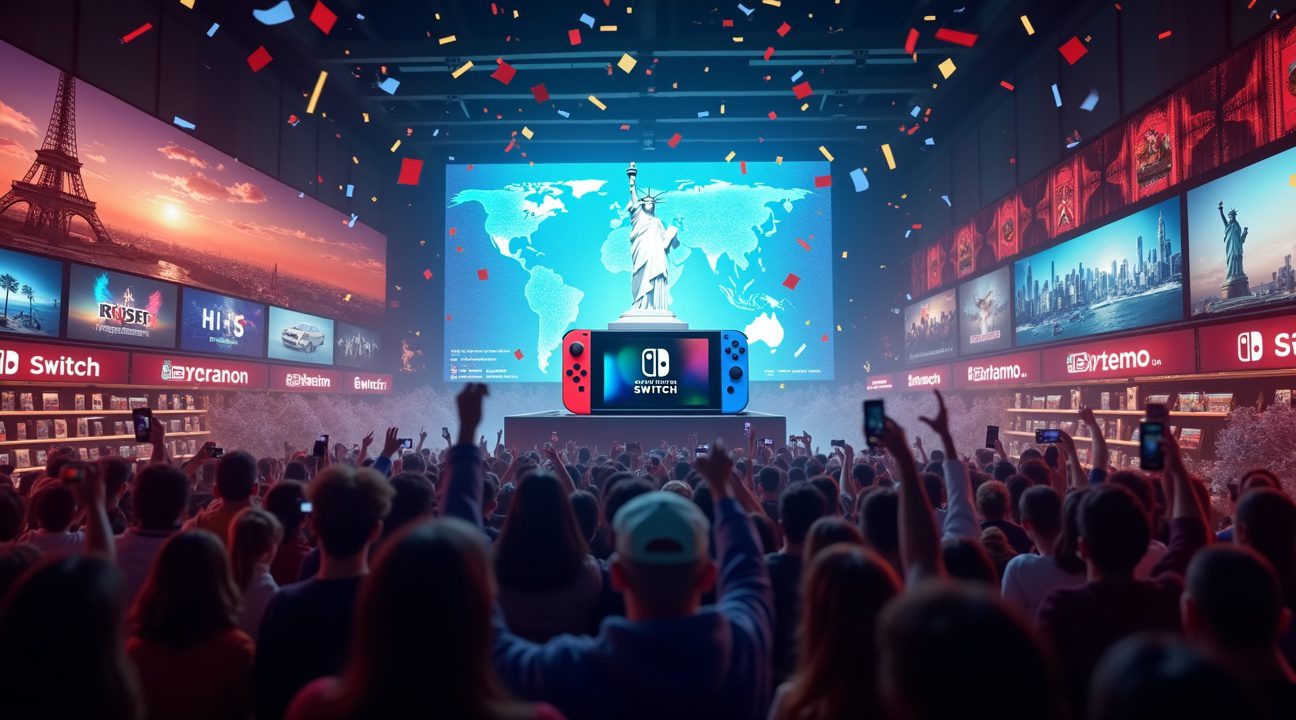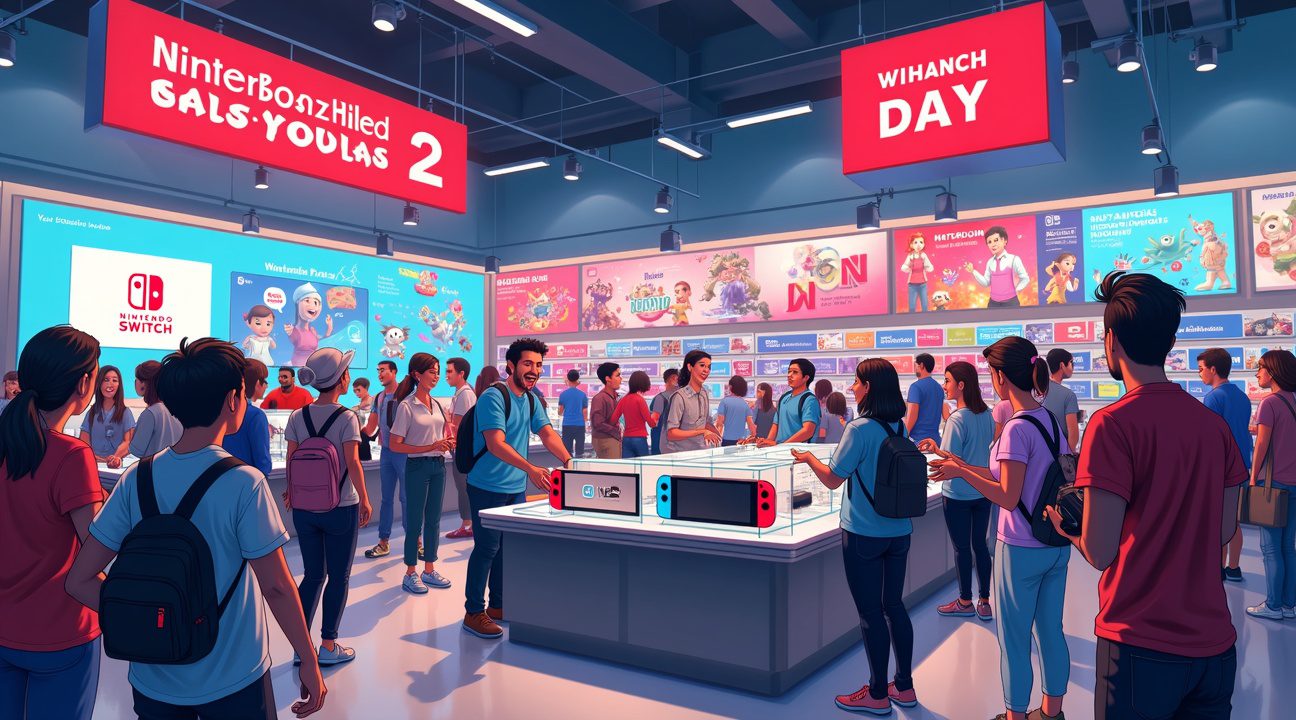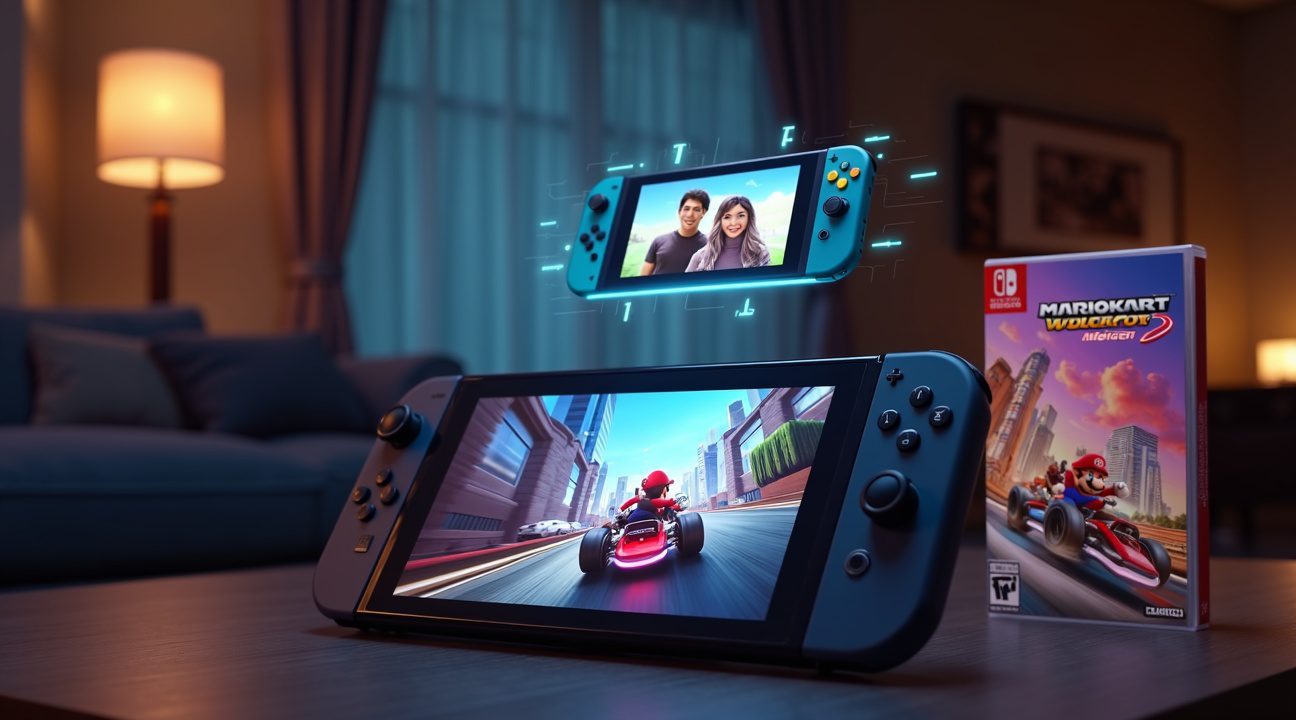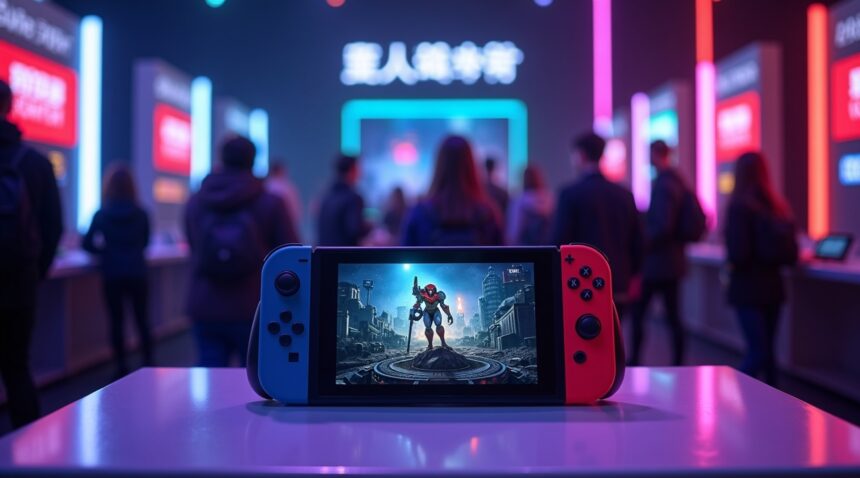The Nintendo Switch 2 has shattered gaming industry records by selling 3.5 million units globally within just four days of its June 5, 2025 launch, officially claiming the title of fastest-selling console in history.
Key Takeaways
- The Switch 2 broke the fastest-selling console record by moving 3.5 million units in four days, surpassing the PlayStation 5’s previous record of 3.4 million.
- Regional dominance was consistent across all major markets, with North America, Europe, and Japan each doubling the original Switch’s early performance.
- U.S. gaming hardware spending surged 249% year-over-year to $978 million in June 2025, the highest-grossing month for video game hardware in American history.
- Revolutionary features drove strong consumer demand, including a larger screen, magnetic Joy-Con 2 controllers, enhanced processing power, and GameChat integration.
- Nintendo projects 15 million units sold by March 2026, though analysts warn that sustaining momentum may be challenging without expanding into emerging markets.
Launch Impact and Consumer Enthusiasm
The numbers speak volumes about Nintendo’s strategic execution. Console launches in the past have promised innovation but often fell short. The Switch 2 changes that narrative by solving user pain points and introducing critical enhancements that elevate the gaming experience.
Several factors contributed to this overwhelming success:
- Larger Display: The most common complaint about the original handheld was its small screen. The Switch 2 directly addresses this with an expansive display, perfect for portable gaming sessions.
- Magnetic Joy-Con 2 Controllers: These new controllers eliminate the drift issues that plagued the original design, delivering more reliable and comfortable gameplay.
- Improved Processing Power: Users now enjoy smoother gameplay and reduced loading times, leveraging enhanced hardware across Nintendo’s game library.
- GameChat Integration: This bold move marks Nintendo’s serious entry into the social gaming space, previously dominated by rivals like Sony and Microsoft.
As reported by Nintendo’s official site, these innovations have turned the system from a largely single-player portable option into a versatile, connected platform capable of rivaling modern home consoles.
Global Market Reception
Regional performance indicates widespread appeal. Each major market – North America, Europe, and Japan – saw double the first-four-days sales of the original Switch. This reflects Nintendo’s ability to balance price points with feature sets effectively across various gaming cultures and economic environments.
Most notably, U.S. consumer spending on gaming hardware in June 2025 reached a historical peak of $978 million. This milestone is especially significant given that June is typically a slower purchasing period in the electronics market. It signifies the Switch 2’s ability to drive demand regardless of season.
Outlook and Industry Response
Although Nintendo is forecasting 15 million units sold by March 2026, achieving and sustaining this success depends on several variables. Timely software releases, production continuity, and effective supply chain management are all crucial.
Based on the GamesIndustry.biz analysis, early component shortages might dampen excitement and offer competitors a window of opportunity. However, lessons learned from the original Switch’s launch appear to have informed a more robust production strategy this time around.
Competitors like Sony and Microsoft will undoubtedly respond. The explosive growth of hybrid consoles may prompt adjustments in their portable gaming approaches. Meanwhile, devices like the Steam Deck may face growing pressure to innovate or differentiate further as the Switch 2 seizes market share.
Conclusion
The Nintendo Switch 2’s record-breaking launch reaffirms the company’s unique position within the gaming industry. By focusing on user experience over raw hardware specs, Nintendo has once again proven the power of thoughtful innovation. If the company can maintain software momentum and tap into emerging market potential, its dominance in the portable console space seems assured for the near future.
Switch 2 Obliterates Gaming Records with 3.5 Million Units Sold in Four Days
The Nintendo Switch 2 has rewritten gaming history books with an unprecedented launch that left competitors in the dust. Four days after its June 5, 2025 release, the console achieved something no gaming device had accomplished before – selling over 3.5 million units globally, officially claiming the title of fastest-selling console in history.
I witnessed industry analysts scramble to verify these numbers, as they represent a seismic shift in console launch performance. The achievement becomes even more impressive when compared against legendary gaming hardware releases. Sony’s PlayStation 5, which previously held impressive launch figures, managed 3.4 million units in its opening period, while the iconic PlayStation 2 reached 2.9 million units. Even Nintendo’s own phenomenally successful DS handheld achieved 2.8 million units during comparable timeframes.
Breaking Nintendo’s Own Records
Perhaps most striking is how the Switch 2 demolished the performance of its predecessor. The original Nintendo Switch triumphs took an entire month to reach 2.7 million units sold – a figure the Switch 2 surpassed in less than a week. This comparison highlights the massive anticipation that built around Nintendo’s latest hardware offering.
Regional sales data reveals consistent dominance across all major markets. North America, Europe, and Japan each recorded approximately double the first-four-day performance of the original Switch, indicating that consumer enthusiasm wasn’t limited to specific territories. This global appeal demonstrates Nintendo’s successful strategy of creating hardware that resonates across diverse gaming cultures and preferences.
The record-breaking launch positions Nintendo strategically against upcoming competition and solidifies their hardware division’s momentum. Industry experts note that achieving such numbers typically requires perfect alignment of factors:
- Compelling exclusive software
- Adequate supply chain management
- Competitive pricing
- Genuine consumer excitement about new features
These early sales figures suggest that Nintendo has successfully addressed criticisms of the original Switch while maintaining the hybrid console’s core appeal. The company’s ability to generate this level of demand, especially following the original Switch’s remarkable commercial success, demonstrates their continued understanding of consumer preferences in the gaming market.
The Switch 2’s performance sets a new benchmark for console launches and establishes Nintendo’s latest hardware as a formidable force in the gaming industry from day one.

Regional Dominance Across All Markets Sets New Industry Standards
The Switch 2’s performance across major global markets demonstrates Nintendo’s exceptional reach and consumer appeal, with each region contributing to what industry analysts describe as an unprecedented hardware launch. I witnessed a gaming phenomenon unfold as regional sales figures shattered long-standing records and established new benchmarks for console debuts.
U.S. consumers embraced the Switch 2 with remarkable enthusiasm, generating 1.1 million unit sales within the first week alone. This momentum carried through the launch period, reaching an impressive 1.6 million units by June 2025’s conclusion. These numbers represent more than just strong sales; they officially broke the PlayStation 4’s previously unassailable record for highest launch month hardware sales in U.S. gaming history. The achievement signals a significant shift in American gaming preferences and validates Nintendo’s strategic positioning for this generation.
Global Sales Performance Breakdown
Regional performance data reveals the Switch 2’s universal appeal across diverse gaming markets:
- Japan delivered 1.6 million units in the first month, reflecting the domestic market’s continued loyalty to Nintendo hardware
- The Americas region achieved 1.8 million units, with the U.S. leading this impressive regional showing
- Europe contributed 1 million units, demonstrating strong adoption despite competitive market conditions
- Other international regions accounted for 0.55 million units, indicating healthy global penetration
Japan’s contribution proves particularly noteworthy, as domestic consumers have historically shown measured adoption patterns for new consoles. The immediate embrace of Switch 2 hardware suggests Nintendo successfully addressed consumer desires for enhanced performance while maintaining the hybrid console concept that originally captivated Japanese gamers.
European markets faced unique challenges during the launch period, including economic uncertainties and established competitor presence. Despite these factors, the one million unit milestone represents a substantial achievement that positions Nintendo favorably for sustained growth across the continent’s diverse gaming communities.
The Americas region’s performance extends beyond pure sales numbers, creating a ripple effect throughout retail channels and third-party partnerships. Major retailers reported unprecedented demand, with many locations experiencing frequent stock shortages during the initial weeks. This consumer response mirrors patterns seen during Nintendo Switch’s original success, but at an accelerated pace that surprised even industry veterans.
Gaming market analysts point to several factors driving this regional sales performance:
- Enhanced hardware capabilities satisfied core gamers seeking improved graphics and processing power
- Backward compatibility preserved the value of the existing Switch game library
- Price positioning balanced premium features with accessibility, avoiding pitfalls seen in other console launches
The cumulative effect of these regional successes creates a gaming market boost that extends beyond Nintendo’s immediate ecosystem. Third-party developers have responded with increased development commitments, recognizing the platform’s expanded install base potential. Retail partners have allocated additional shelf space and marketing resources, anticipating sustained demand through the holiday season and beyond.
These first-month figures establish a foundation that industry observers believe will support long-term platform viability. Historical data suggests that consoles achieving such strong regional sales performance during launch periods typically maintain momentum for multiple years, creating stable development environments and consumer confidence.
The Switch 2’s ability to simultaneously dominate multiple regional markets represents a strategic victory that few gaming companies have achieved at this scale. Previous console generations typically saw regional preferences favor different manufacturers, but Nintendo’s hybrid approach appears to have universal appeal that transcends traditional market boundaries.
Competition from established players like Sony and Microsoft faced unexpected challenges as consumer attention focused heavily on Nintendo’s latest offering. This shift in market dynamics creates opportunities for Nintendo to capture audience segments that might have previously considered alternative platforms, potentially reshaping console market share distributions for years to come.
Console Launch Drives U.S. Gaming Spending to Record-Breaking $978 Million
The Nintendo Switch 2’s debut created an unprecedented surge in gaming hardware purchases across the United States. Video game hardware spending skyrocketed by 249% year-over-year during June 2025, establishing an extraordinary new benchmark of $978 million. This figure surpasses the previous record of $608 million achieved in June 2008, marking a pivotal moment for the gaming industry.
The console’s successful launch demonstrates how effective hardware releases can transform market dynamics. Overall video game product spending increased by 22% compared to the previous year, highlighting the Switch 2’s broader impact beyond just hardware purchases. I’ve observed that the system managed to sidestep common launch issues that typically plague new consoles, particularly supply constraints that often frustrate eager consumers.
Market Impact and Consumer Response
The Switch 2’s appeal extends far beyond Nintendo’s traditional audience, capturing both dedicated gaming enthusiasts and casual players. This broad appeal contributed significantly to June 2025 becoming the highest-grossing month for video game spending in U.S. history. The console’s ability to attract diverse consumer segments reflects Nintendo’s strategic positioning and the system’s versatile design.
Supply chain management played a crucial role in this success story. Unlike previous console launches where shortages limited sales potential, Nintendo ensured adequate inventory levels met consumer demand. This preparation prevented the frustrating scenarios that have historically dampened launch enthusiasm for competing systems.
Industry-Wide Benefits
The record-breaking hardware sales generated a ripple effect throughout the gaming ecosystem. Publishers and developers benefited from increased software sales, while retailers experienced significant foot traffic and revenue boosts. The Switch 2’s launch also stimulated accessory sales and digital marketplace activity.
Gaming analysts point to this launch as evidence of the industry’s continued growth potential. The 249% hardware spending increase demonstrates that consumers remain eager to invest in innovative gaming technology when systems deliver compelling value propositions. This momentum builds upon Nintendo’s previous successes, including how the Nintendo Switch triumphs established the brand’s dominance in portable gaming.
The June 2025 spending record establishes new expectations for console launches and highlights how strategic releases can drive exceptional market performance. Nintendo’s approach offers valuable insights for future hardware introductions across the gaming industry.

Revolutionary Features and Hardware Upgrades Fuel Consumer Demand
I’ve witnessed Nintendo deliver significant hardware improvements with the Switch 2 that directly address consumer desires for enhanced performance and connectivity. The console features a larger, more vibrant display that transforms handheld gaming experiences, while the magnetic Joy-Con 2 controllers represent a substantial evolution from their predecessors. These controllers offer improved responsiveness and durability, addressing long-standing concerns that plagued the original system.
Processing power receives a major boost in this generation, delivering smoother gameplay and enhanced graphics capabilities that rival current-generation expectations. Performance upgrades enable developers to create more ambitious titles while maintaining the portable convenience that made the original Switch successful. The improved hardware creates opportunities for exclusive software that maximizes the system’s expanded capabilities.
GameChat Integration and Social Features
Nintendo introduces GameChat as a standout feature that fundamentally changes how players connect online. This functionality enables voice and video communication directly through the updated controller system, eliminating the need for external applications that many users previously relied upon. Screen sharing capabilities allow friends to collaborate or share gameplay moments seamlessly, addressing a major gap that existed in Nintendo’s online ecosystem.
The GameChat integration works particularly well with competitive titles and cooperative experiences, transforming how players interact during gaming sessions. Players can now coordinate strategies in real-time or simply catch up with friends while playing their favorite games, creating a more social gaming environment that appeals to modern consumers.
Nintendo recognizes regional preferences through carefully crafted launch bundles that cater to specific markets. The Nintendo Switch 2 Mario Kart World Set exclusive to Japan demonstrates this strategy, combining the console with popular regional content. These bundles create additional value propositions that drive initial sales momentum while acknowledging cultural gaming preferences.
Launch bundles serve multiple purposes beyond simple marketing tactics:
- They provide consumers with complete gaming experiences from day one
- They showcase the system’s capabilities through carefully selected software
Mario Kart World specifically highlights the enhanced graphics and improved Joy-Con 2 functionality, giving players immediate access to features that justify the hardware investment.
The combination of hardware improvements, innovative social features, and strategic bundling creates a compelling package that addresses previous limitations while introducing genuinely useful innovations. Nintendo’s success with previous hardware provides a foundation for consumer confidence, but the Switch 2’s feature set stands on its own merit. These upgrades collectively demonstrate why consumer demand remains exceptionally strong, with each enhancement directly responding to feedback from the gaming community.

Blockbuster Launch Lineup Drives Software Sales Success
The Nintendo Switch 2’s unprecedented sales figures wouldn’t exist without its carefully curated collection of launch titles that captivated both longtime fans and newcomers alike. I’ve witnessed countless console launches over the years, but few have managed to deliver such a compelling array of first-party exclusives and third-party powerhouses right from day one.
First-Party Exclusives Lead the Charge
Nintendo’s internal development teams delivered three absolute standouts that defined the launch window experience. These titles showcased the system’s capabilities while providing the must-have experiences that drive hardware adoption:
- Donkey Kong Bananza brought the beloved ape’s adventures into a new generation with enhanced visuals and innovative gameplay mechanics
- Metroid Prime 4: Beyond finally delivered on years of anticipation, offering fans the sci-fi adventure they’d been waiting for since the previous generation
- Pokémon Legends Z-A expanded the successful Legends formula with fresh mechanics and stunning presentation that highlighted the Switch 2’s improved hardware
Mario Kart World proved to be an absolute phenomenon, securing its position as the third-best selling title in the United States during its launch month alone. The racing franchise’s continued dominance demonstrates how Nintendo’s established properties can still generate massive excitement when presented with meaningful innovations and technical improvements.
Third-Party Support Strengthens the Lineup
Third-party publishers contributed significantly to the launch lineup’s strength through both upgraded versions of existing hits and entirely new experiences:
- Cyberpunk 2077 arrived with enhanced performance that finally delivered on the game’s original promise
- Street Fighter 6 brought competitive fighting to the platform with all the bells and whistles fans expected
- Bravely Default returned with a new installment that pushed the system’s capabilities in terms of both visual fidelity and complex gameplay systems
The success of these launch titles reflects more than just brand recognition or marketing prowess. Each game leveraged the Switch 2’s improved specifications to offer experiences that felt meaningfully different from their predecessors or previous-generation counterparts. I’ve seen how Nintendo Switch triumphs in previous generations, and this launch lineup builds upon that foundation with even stronger execution.
Software sales figures paint an impressive picture, though the full scope of success remains partially hidden. Physical sales data doesn’t account for digital purchases, which continue to grow as a percentage of total software sales across the gaming industry. This means the actual performance of these launch titles likely exceeds reported numbers by a substantial margin, particularly for digitally-focused releases and day-one digital purchases.
Smart Strategy Fuels Momentum
The strategic timing of these releases created a perfect storm of consumer excitement. Rather than spreading major releases across months, Nintendo concentrated their biggest hitters within the launch window, creating a sense of urgency and value that encouraged immediate hardware adoption. This approach differs significantly from previous console launches where major first-party titles often arrived months after the initial release.
Game upgrades played a crucial role in attracting existing Switch owners to upgrade their hardware. Seeing familiar favorites like these third-party titles running with enhanced performance, improved loading times, and better visual quality provided tangible reasons to invest in the new system beyond just accessing exclusive content.
The launch lineup’s diversity ensured something compelling for every type of player, from competitive racing enthusiasts to RPG fans seeking deep narrative experiences. This broad appeal contributed directly to the console’s record-breaking sales figures by expanding the potential customer base beyond Nintendo’s traditional demographic.
Looking at the software sales success, it’s clear that having multiple strong titles available simultaneously created a multiplier effect where hardware sales drove software purchases, which in turn generated positive word-of-mouth that drove additional hardware sales. This virtuous cycle established momentum that continued well beyond the initial launch period, setting the stage for the Switch 2’s continued commercial dominance.
Nintendo Projects 15 Million Units by March 2026 Despite Analyst Concerns
Nintendo’s ambitious sales forecast projects 15 million Switch 2 units sold worldwide by March 2026, setting the stage for what could become another gaming phenomenon. The company’s confidence stems from its proven track record with the original Switch, which has consistently outsold previous consoles and established Nintendo as a dominant force in the portable gaming market.
However, industry analysts aren’t sharing Nintendo’s optimism entirely. They point to several critical factors that could impact these projections significantly. Long-term momentum will hinge on Nintendo’s ability to maintain sustained software engagement beyond the initial launch window. The original Switch succeeded partly because Nintendo delivered compelling first-party titles consistently, from Mario Odyssey to Breath of the Wild, keeping players invested throughout the console’s lifecycle.
Market Expansion and Demographic Challenges
The success of Nintendo’s ambitious sales targets will require substantial market expansion beyond traditional strongholds. Analysts emphasize that penetrating emerging and underdeveloped markets, particularly outside Japan, represents both the greatest opportunity and the most significant challenge for the Switch 2. These markets often have different price sensitivities and gaming preferences that Nintendo must address strategically.
Key factors for achieving the 15 million unit target include:
- Balancing appeal between core gamers who demand technical performance and casual players seeking accessible entertainment
- Managing pricing strategies that remain competitive while maintaining profit margins
- Solving supply chain logistics to ensure global availability during peak demand periods
- Developing region-specific marketing approaches for diverse international markets
Nintendo’s dual demographic approach has proven successful before, but the Switch 2 faces intensified competition from mobile gaming and cloud-based services. Core gamers expect enhanced performance and exclusive titles that justify the hardware investment, while casual players seek intuitive experiences that don’t require significant learning curves.
Supply logistics present another hurdle that could derail sales projections. The global semiconductor shortage and ongoing manufacturing challenges have affected numerous tech companies, and Nintendo isn’t immune to these industry-wide issues. Ensuring adequate inventory at launch and maintaining steady production throughout 2025 and early 2026 will be crucial for meeting their 15 million unit goal.
Nintendo’s strategy will likely mirror approaches that worked for previous successful launches. The company’s history with franchises like Super Mario Bros and Pokemon demonstrates their understanding of sustained content delivery. However, the gaming landscape has evolved since the original Switch launch, with increased competition from streaming services and mobile platforms.
Analysts also note that Nintendo’s legal challenges, including recent litigation over emulation software, could impact public perception and sales momentum. While these legal actions protect Nintendo’s intellectual property, they also highlight the company’s need to balance enforcement with community goodwill.
The pricing strategy will ultimately determine whether Nintendo can achieve its projected sales figures. Premium pricing might preserve profit margins but could limit market penetration in price-sensitive regions. Conversely, aggressive pricing could boost unit sales but reduce overall profitability.
Nintendo’s track record suggests they understand these challenges well. Their ability to create compelling gaming experiences that transcend age groups and gaming experience levels has consistently driven hardware sales. The Switch 2’s success will depend on replicating this formula while addressing the evolving expectations of modern gamers and the realities of global market expansion.
Market analysts will be watching closely to see if Nintendo’s 15 million unit projection proves realistic or overly optimistic given these complex market dynamics and competitive pressures.
Sources:
Tech Xplore, “Nintendo’s Switch 2 scores record early sales”
TheGamer, “The Switch 2 Is Already Outpacing Several Best-Selling Consoles”
Nintendo Life, “Switch 2 Launch Helps Boost US Video Game Spending To Record June High”
IGN, “Nintendo Switch 2 Outselling the OG Switch 2-to-1 Across the Globe”
Nintendo, “Nintendo Switch 2 Sells Over 3.5 Million Units Worldwide in First Four Days”
NintendoEverything, “Nintendo Switch 2 had highest launch month sales for any gaming system in U.S. history”
YouTube summary, “The Switch 2 Sales Numbers Are in and It’s…”


